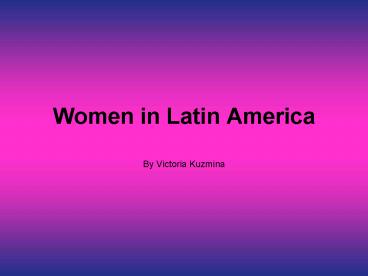Women in Latin America - PowerPoint PPT Presentation
1 / 11
Title:
Women in Latin America
Description:
Women stay within household until they are married; -Family reputation measured by ... Ms Bachelet was jailed and tortured by Chile's Pinochet military junta; ... – PowerPoint PPT presentation
Number of Views:58
Avg rating:3.0/5.0
Title: Women in Latin America
1
Women in Latin America
- By Victoria Kuzmina
2
Gender Roles
- Traditional
- -Women stay within household until they are
married - -Family reputation measured by number of
children. - -Patriarchy father has unquestionable authority
- -Men are allowed to have sexual experience before
marriage and external affairs after marriage - -Machismo men are dominant, can even be
aggressive, supply family economically, guide
women in life. - -Marianismo protect children an family honor,
submissive to men, work at home.
- Modern
- -Financial pressure Both family members work
outside the family. - -Women work average family size is smaller, less
time for children. - -Women have more education and employment
opportunities, more self-confidence, machismo is
challenged. - -Women are active politically, guerilla
movements, presidents, senators. - -National womens movements advocate womens
rights
3
Latin American Feminism
- Feminine v Feminist interests
- Feminine interests- improvement of womens
ability to fulfill traditional gendered roles
(mothers, educators), also called practical
gender interests. - Feminist interests- reconstruction of social
codes and gendered division of roles. - WID (Women In Development) and WAD (Women and
Development) - WID approach-political and economic
empowerment of women, enforcing womens legal
rights, equal education and employment
opportunities. - WAD approach-criticize WID activists for
disregarding barriers of womens development,
such as race and social class.
4
Eva Peron (Argentina)
- Started her career as an actress on the radio and
in films - 1945- married Colonel Juan Domingo Peron.
- Helped gather support for Peron among the poorer
sectors of population - Leader of Womens Branch of Peronist Party
- Eva Peron Foundation- supported poor and working
classes, offered social welfare services - 1947- promoted suffrage right for women
- Promoted equal rights for illegitimate children
- Passionate speech-maker, great support for
president Peron
5
Michelle Bachelet (Chile)
- Elected as a President in Jan. 2006 (Christian
Democratic Party) - Ms Bachelet was jailed and tortured by Chile's
Pinochet military junta - promised to build a more open, diverse and
tolerant society - Wants to bridge the gap between rich and poor and
empower women and indigenous people - Built a 1st gender-balanced administration in
history of Chile - Will continue pro-free market policies, improve
economy performance
6
Womens Activism in Latin America
- Raised public awareness, attracted attention of
international human rights organizations - Questioned autocratic and brutal regimes,
undermined their legitimacy and called their
rulers to account (Brazil, Chile, Argentina) - Promoted electoral democracy
- Joined revolutionary movements (Sandinista,
Zapatista Movements) - Focused on womens civil status, labor laws,
educational opportunity - Suffrage struggles
- Increased political participation, presented a
fresh alternative to male leadership (Argentina,
Cuba, Nicaragua, Chile) - 4th World Conference on Women (1995 Beijing)-
decrease of womens underrepresentation in
legislative bodies, introduce quotas for female
representation in national parliaments. - Quota Laws- political parties increase number
of female candidates (20-30).
7
Violence, Power and Gender
- Gender, race and social class remain main
barriers for womens equal participation in
social, political and economic life - Women are victims of domestic violence, sexual
harassment, sexual abuse by security forces
(Mexico case) - Weak legal protection (Guatemala case)
- Insufficient political and economic
representation caused by traditional concept of
womens work - Women are victims of neo-liberal policies,
Structural Adjustment Programs.
8
Why are women the victims of SAPs?
- Neo-liberal economic theories are neutral but
they are often implemented in social environments
which are not gender neutral (conventionally
recognized womens work assumptions are still
alive) - Reduced public spending on health result
increasing health problems for women/mothers - Cost recovery principles were introduced in
many adjusting states which reduced girls
chances for education - Through devaluation and subsidy cuts the prices
for goods are rising- womens household manager
roles are made more difficult - Women are severely effected by rationalization
of inefficient businesses whereby many female
workers (low-level and unskilled positions) lose
their jobs - Some export-orientated industries prefer hiring
female workers (as manufacturing workforce) to
reduce variable production costs because women
are less likely to complain about poor working
conditions and low wages or organize strikes.
They are also better in detailed work and are
easier to control by skilled male supervisors.
9
Do Democratic Regimes Provide More Opportunities
for Women?
- Suffrage rights granted by autocratic and
semi-democratic regimes (Argentina, Brazil,
Chile, Mexico) - Conservative regimes wanted to gain support of
female electorate, imposed (without democratic
debate) reforms which promoted womens interests,
granted property rights for women, equal
responsibility for child care (Argentina, Brazil,
Chile) - Young democratic regimes desired to dominate in
the government, distributed high ranking
positions among themselves and their colleges,
disregarded womens demand for political and
economic participation
10
Bibliography
- Smith, Peter H. (2005), Democracy in Latin
America, Oxford University Press, New York. - Vanden, Harry E., Prevost, Gary (2nd ed.) (2006),
Politics of Latin America, Oxford University
Press, New York. - Desai, V. and Potter, R.B. (ed.) (2002), The
Companion to Development, Hodder Arnold, London. - http//www.amnestyusa.org/news/document.do?idENGU
SA20061005001 - http//www.chileangovernment.cl
- http//news.bbc.co.uk/2/hi/americas
- www.usaid.gov/our_work/cross-cutting_programs/wid/
index.html - www.mujeres.amnistia.org.mx/section.php?namenotic
ias_23112004
11
Questions?































